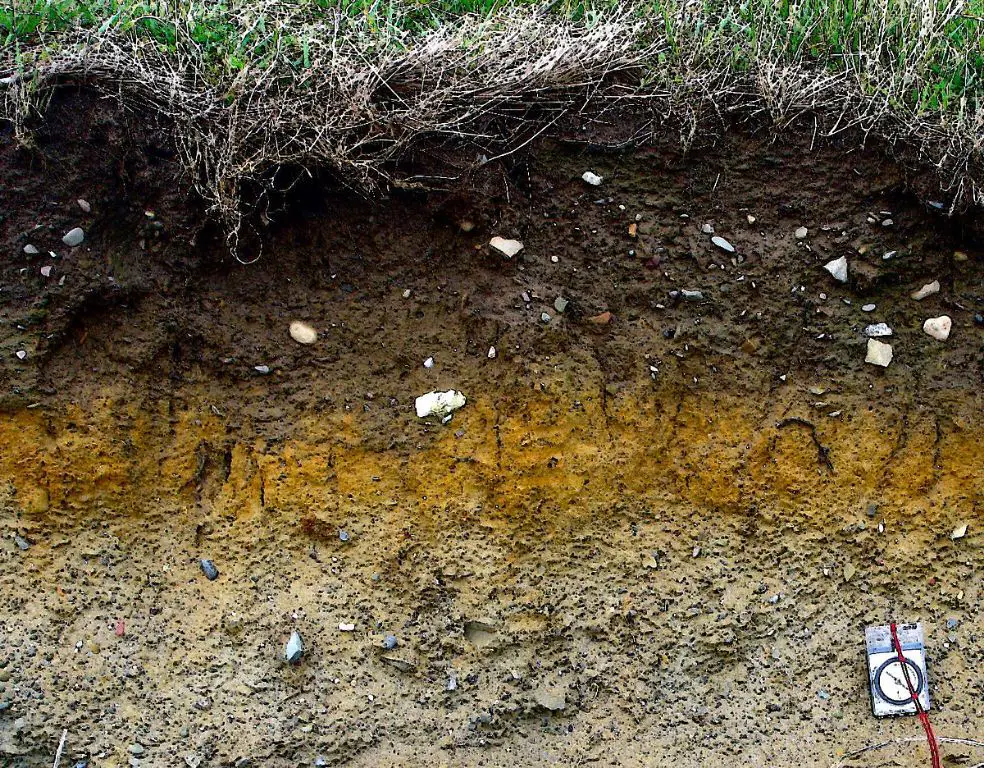Is Clay Soil Or Dirt?
What is Clay?
Clay is a fine-grained natural soil material composed primarily of clay minerals such as silica and alumina. Clay particles are smaller than silt and sand grains, measuring less than 0.002 mm in diameter. This small size gives clay unique properties and plasticity when wet that distinguish it from other soils. Clay soils develop plasticity due to the flat shape of clay particles and their crystalline structure, allowing water to penetrate between layers.
Clay forms over long periods as rocks break down from weathering and soils washed from upland areas are deposited. Clay soils are common in many parts of the world, especially ancient river floodplains and deltas like the Mississippi River. The composition of clay allows it to harden when fired or dried in the sun, making it useful for pottery, bricks, and construction materials.
According to https://sciencing.com/how-is-clay-soil-formed-13406937.html, clay’s small size and layer structure create unique physical and chemical properties that differentiate it from other types of soils. When wet, the spaces between clay’s thin stacked sheets allow water absorption and plasticity. When dry, clay becomes hard and solid. These traits make clay a valuable material, but also a challenging type of soil.
Properties of Clay
Clay soil has some defining characteristics that set it apart from other soil types. Some key properties of clay soil include:
Clay is sticky and binds together easily. The small particle size and platelike shape of clay allow the particles to adhere to each other more tightly than other soils. This gives clay a sticky consistency that allows it to be molded when wet.1
Clay has poor drainage. The tight spaces between clay particles make it more difficult for water to permeate through the soil. As a result, water tends to collect on the surface of clay soils and drain very slowly.2
When dry, clay becomes very hard. As clay loses moisture, the soil particles bind even more tightly together, forming a dense, extremely hard layer that can become brick or concrete-like.1
Clay shrinks and cracks when dry. The loss of moisture causes clay to contract and shrink, often forming deep cracks and fissures in the ground as it dries out.2
What is Dirt?
Dirt is made up of loose earth material called soil. It is a mixture of clay, silt, sand, and organic matter such as decomposed leaves, roots, and animal remains (https://en.wikipedia.org/wiki/Soil). Dirt refers to soil that is unfit for growing plants and does not contain the necessary nutrients, minerals, microorganisms, and organic matter that healthy soil contains (https://naturespath.com/blogs/posts/difference-soil-dirt).
The major components of dirt are:
- Clay – Fine-grained particles that feel sticky when wet.
- Silt – Coarse-grained particles that have a smooth, floury texture.
- Sand – Gritty particles that are visible to the naked eye.
- Organic matter – Decomposed plants, animals, microbes, and humus.
While dirt contains these components, it lacks the balanced mixture and biological activity that allows soil to support plant life. Essentially, dirt refers to low quality soil that does not contain adequate nutrients for plants to grow.
Comparing Clay and Dirt

Clay is a specific component and texture of soil, while dirt is a generalized term for the mixture of many materials that make up the upper layer of the earth’s surface. Dirt contains a variety of components including sand, silt, clay, and organic matter (Source).
Clay consists of the smallest particles of soil, less than 0.002 mm in size. It has a sticky, plastic consistency when wet and is dense and hard when dry (Source). Clay particles are flat and plate-shaped, allowing them to pack together tightly.
In comparison, dirt is a loose mixture of materials without a specific composition. Along with clay, dirt also contains materials like silt (particles between 0.002 – 0.05 mm), sand (particles between 0.05 – 2 mm), and organic matter from decayed plants and animals (Source). The exact composition varies based on the location.
So in summary, clay is a distinct component of soil focused on the smallest particles. Dirt refers broadly to the full mixture of organic matter, minerals, liquids and organisms covering the surface of the earth.
Using Clay Soil
Clay soil is a very useful type of soil that has many applications. One of the main uses of clay soil is that it binds and strengthens other types of soils. Adding clay to sandy soils helps to retain moisture and nutrients. Clay also adds structure and stability to soil, improving its workability.
Another common use of clay soils is in the production of pottery, bricks, ceramics and other clay products. The plasticity and moldability make clay idea for shaping into useful and decorative objects. Clay has been used for pottery dating back thousands of years, and continues to be an important material for artisans today. Specific types of clay are essential for achieving the desired characteristics in different clay products.
According to https://civiltoday.com/civil-engineering-materials/sand/315-uses-of-clay-soil, clay’s resistance to heat and low permeability make it useful for lining furnaces, kilns, and fireplaces. When fired at high temperatures, clay becomes permanently hard and is used in floor and roof tiles, pipes, and bricks in the construction industry.
Challenges of Clay Soil
Clay soils pose several challenges for gardeners and farmers. The small size of clay particles creates a soil structure that faces issues with drainage and compaction.
Poor drainage is one of the biggest disadvantages of clay soils. The tiny size of clay particles means there are only small air spaces in between them for water drainage. As a result, water tends to pool on the surface of clay soils and takes a long time to percolate down. This can lead to overly wet soil that is prone to waterlogging after rain or irrigation 1.
When clay soils dry out, they become very hard and compact. The dense structure leaves little room for air and water movement. Plant roots have difficulty penetrating through compacted clay, stunting their growth. Clay particles stick together tightly when dry, forming nearly impenetrable chunks. However, clay turns slippery and muddy when wet. These extreme shifts between dusty hard clay and slick mud make it challenging to work with 2.
The poor aeration and drainage of clay soils also leads to nutrient deficiencies. With little air space, oxygen movement is limited, slowing decomposition of organic matter. Lack of drainage prevents leaching of salts and minerals. This causes a buildup of sodium and alkaline pH levels. Nutrient imbalances then starve plants of key elements like iron, manganese, and zinc 3.
Improving Clay Soils
Clay soil can be difficult to work with because of its dense, compact nature that makes it challenging for plant roots to penetrate and absorb nutrients and water. However, there are methods gardeners can use to improve the structure and drainage of clay soil to make it more hospitable for plants.
One effective strategy is to incorporate organic matter like compost or coarse sand into the clay soil. Compost introduces nutrients while also helping to break up heavy clay and improve drainage and aeration. Coarse sand particles act to physically separate clay particles so they don’t clump together as tightly. To amend clay soil, add 1 to 2 inches of compost or coarse sand and mix thoroughly into the top 6 to 8 inches of soil before planting. For best results, double-dig the bed by digging out soil in trenches and mixing amendments into the subsoil as well (How to Improve and Amend Clay Soil).
Additionally, choosing plants suited to heavy, dense clay can help improve success. Look for native plants adapted to your climate and plants described as tolerant of wet, clay soils. Examples include ornamental grasses, Russian sage, gas plant, sedges, astilbe, and black-eyed Susan. Avoid plants that prefer sandy, well-draining soils. With some amendments and careful plant choices, clay soil can be very fertile and provide an excellent medium for gardening (Like diamonds, clay soils are forever).
Types of Clay
There are several different types of clay soil, classified according to their mineral composition:
- Kaolin – Also known as china clay, kaolin has a low shrink-swell capacity and is used to make porcelain. It is usually white in color.
- Montmorillonite – This type of clay swells greatly when wet and shrinks when dry. It is sticky and can be slippery when wet. Montmorillonite is used in drilling fluids.
- Illite – Illite clay has moderate shrink-swell capacity. It is non-sticky and tends to appear silver or gray. Illite is used in ceramics and as a soil conditioner.
- Smectite – With a high shrink-swell capacity, smectite clays are slippery and sticky when wet. They are used as absorbents and thickeners.
- Vermiculite – Similar to montmorillonite, vermiculite has a very high cation exchange capacity. It expands greatly when heated and is used as insulation.
Some other types of clay include halloysite, bentonite, and ball clay. The specific properties and mineral content differentiate the various clay types and determine their best uses.
Source: https://www.hunker.com/12003887/different-types-of-clay-soil
Clay Soil Geography
Clay soils are found across many parts of the world, both in tropical and temperate zones. According to Where is Clay Found?, clay deposits “can be found on every continent except Antarctica.” Clay tends to form in wet, humid environments through the weathering and decomposition of certain rock types like feldspar. The tropics provide an ideal climate for this process, which is why large clay deposits are common in tropical regions.
That said, clay is also abundant in many temperate areas. The source notes that major clay deposits can be found across Europe, North America, and Asia. In the United States specifically, clay soils are common across the Southeast and Midwest. The Mississippi River Delta contains heavy clay soils, while glacial clay deposits are found throughout the North Central states. So while the tropics contain ideal conditions for clay formation, significant clay deposits exist across many parts of the world.
Conclusion
To recap the main points, clay is a specific component that makes up certain types of soil and dirt. While dirt refers broadly to earth materials like sand, silt and clay, clay has unique properties compared to other soils due to its tiny, flat-shaped particles.
Clay particles are less than 0.002 mm in size, which gives clay its plasticity and ability to harden when dry. The small size and flat shape allow clay particles to pack tightly together, creating heavy, dense soils with poor drainage. This results in key differences between clay soils and other soil types like sandy or silty soils which have larger, irregularly shaped particles.
Clay’s properties pose challenges for agriculture and construction, but also provide benefits for pottery, sculpting and industrial uses. With proper soil management techniques like adding organic matter, clay soils can be productive for farming. Overall, clay is an essential part of certain soil environments with unique qualities setting it apart from the broader dirt category.


